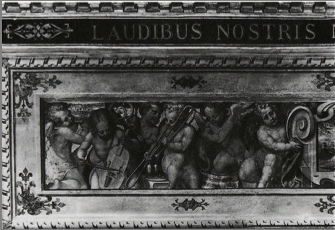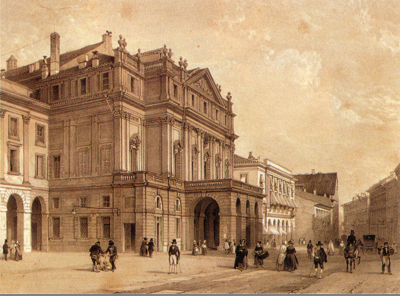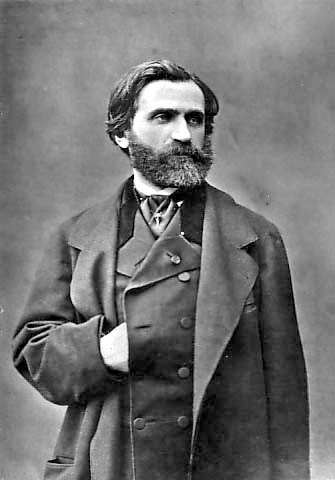Milan is a city known for both high fashion and opera (home of Giuseppe Verdi and La Scala opera house). But trombone? I recently added a number of entries centering around Milan to the Trombone History Timeline, revealing a fairly active trombone performance tradition in that city. The history of the trombone in Milan seems to begin in the 15th century with the wind band, or alta capella, followed by at least a certain amount of activity in religious music in the late 16th and early 17th centuries. Then, following this relatively steady trombone activity of approximately 200 years, there is a large gap until the 19th century, when the trombone is picked back up as a Romantic-era instrument in connection with La Scala’s opera orchestra and Verdi’s operatic works. The Milan Conservatory, founded in 1808, soon includes a trombone studio. Milan also becomes a center for publication of methods and treatises that include trombone, as well as a center for the manufacturing of brass instruments (including contrabass trombones). For reference, I’ve included all of the Milan entries from the Timeline together below. Sources are found in the Trombone History Bibliography.
1466—Milan, Italy: The civic wind band consists of 4 pifferi and 2 trombones (D’Accone, Civic Muse 527).
1468—Milan, Italy: 6 trombones, 11 pifferi, and 33 trumpets play for a political gathering (Kurtzman, Trombe).
1469—Milan, Italy: Trombonists from Germany or the Low Countries are in the service of the Duke of Milan (Galpin, The Sackbut).
1490—Milan, Italy: At the Sforza court, a Festa del Paradiso is held in honor of Isabella d’Aragona. Shortly before the festa begins, “When everyone was seated, the piferi and trombones began to play. After they had played for a while, they stopped, and some tambourin players were ordered to play…” (Merkley 419).
1502—Louis XII of France travels to Milan, returning with 6 trombonists and shawmists, whom he employs at his court for 120 livres per year (Dobbins, Music 126; Cazeaux 240).
1553—Milan, Italy: Ferrante Gonzaga, governor of Milan, maintains a wind band that includes at least one trombone. When a trombonist by the name of Orfeo requests to be released from his service to play elsewhere, the leader of the ensemble expresses alarm, writing to the governor that it “would be in grand damage to the music of your Excellency” (Getz 170).
1559—Milan, Italy: Carnival celebrations at the Milanese court include “an excellent music of bowed viols, trombones [tromboni], cornets, and voices…playing their instruments so sweetly and harmoniously [soavemente che all’armonia]” (Getz 201).
1574—Milan, Italy: A mascherata held in honor of Duke Johann of Austria includes a pastoral scene in which numerous instruments are used: “5 trombetti…cornetto, trombone, cornamusa, fifre, dolzana, flauto, diana, spinetta, viola di gamba, violino, liuto, lira, cetera, piva, doulcemele, contralto di viola, triangolo, tamborino e zufolo, arpa, buttafoco, sordina e mantica, tiorba, quattro viole da braccio” (Boydell, Crumhorn 296).
c. 1580—Milan, Italy: Aureliano Luini depicts an angel playing trombone in his fresco, Musical Angels (see facing image; public domain) (Milan, S. Simpliciano; Kendrick, Sounds of Milan 77).
1605-06—Milan Italy: During a diocesan inquiry about monks’ use of outside musicians at St. Amrogio, witnesses, including a paid trombonist himself, testify to the presence of singers, violins, trombones, and cornetto, along with an occasional lute (Kendrick, Sounds of Milan 79).
1610—Milan, Italy: Giovanni Paolo Cima specifies trombone in works from his collection Concerti ecclesiastici, including Sonata (trombone or violone) and Cappriccio d’Andrea Cima a 4 (1 trombone) (Collver 47).
1620—Milan, Italy: Francesco Rognione’s improvisational treatise, Selva di varii passaggi,includes a setting of Lassus’s song, Susanne un jour. Marked “Modo di passegiar il violone over trombone alla bastarda,” it features rapid technical passages to be played on either violone or trombone (Baines, Brass 114; Guion, Short History; Herbert, Trombone 87).
1649—Milan, Italy: Biagio Marini calls for trombone in a collection of his works (Selfridge-Field, Instrumentation).
1808—Milan, Italy: The Milan Conservatory is founded. A studio of horn, trumpet, and trombone is established, taught by the horn instructor. The first trombone class is established in 1882, with Gaetano Falda as instructor (Herbert, Trombone 130).
1814—Milan, Italy: La Scala orchestra includes 1 trombone (Herbert, Trombone 333).
1824—Milan, Italy: Francesco Mirecki, a Polish musician active in Italy, mentions trombone in his treatise, the earliest known Italian orchestration treatise. He considers bass trombone a useful alternative to serpent as the effective bass of the brass family (Meucci).
1825—Milan, Italy: La Scala orchestra includes 3 trombones (in contrast to 1 in 1814) (Herbert, Trombone 334).
1844—Milan, Italy: Fermo Bellini’s Teoriche musicali discusses the use of trombone with ophicleide: “The modern custom, adopted by some composers, of forming a quartet consisting of three trombones and an ophicleide does not seem very sensible, given that the tone colour of the trombones, so dominant and in high relief, is very different from that of the ophicleide; it would be better for this instrument to double the bottom line, or else to find some way to give the trombones a good cantabile bass whenever they are on their own” (Meucci).
1871—Milan, Italy: Giuseppe Verdi makes the following comment about bass trombone in a letter to his publisher about the forthcoming Italian premiere of Aida: “I must insist on the fourth trombone. That bombardon is impossible. Tell Faccio [the conductor] to consult the first trombonist if he thinks fit, to see what should be done. I should prefer a bass trombone, which is of the same family as the others: but if it proves too tiring and difficult to play, take one of the usual ophicleides which go down to low B. In short, do whatever you please, but not that devil of a bombardon which does not blend with the others” (Leavis, Cimbasso).
1874—Giuseppe Verdi composes his Manzoni Requiem, often called his “greatest opera,” in honor of poet-patriot Alessandro Manzoni. Premiered a year later at the Church of San Marco, Milan, the work calls for 3 trombones. The “Dies irae,” in particular, in which “volcanic anger is depicted by the powerful brass and timpani,” utilizes trombone prominently (Chase 300).
1881—Milan, Italy: The newspaper Gazzetta Musicale di Milano runs an article titled “Visit by Verdi to the Pelitti factory,” detailing Verdi’s interest in the contrabass trombone. It says, in part, “Verdi having, however, expressed certain wishes regarding the range of the trombone basso, Cav. Pelitti undertook to build a new one for the following Thursday which would satisfy the Maestro’s requirements. Verdi, accompanied by maestro Boito and signor Giulio Ricordi, went accordingly on that day to the Pelitti factory where repeated experiments were made with the new trombone in B flat pitched one octave lower than the tenor. The new instrument gave splendid results regarding range, timbre, sonority, power, ease and facility of execution, blending perfectly with the other trombones. Resulting from this, two B flat tenor trombones, a bass trombone in F and the new bass trombone in B flat are necessary in order to achieve a trombone quartet that is perfect, homogeneous and effective without bringing into the orchestra a timbre from the band that would affect the instrumental blending of the various instruments” (Meucci).
1893—Milan, Italy: Giuseppe Ascalone says the following about the timbre of trombones in his Manualetto: “While on its own the bass tuba is an excellent orchestral instrument on account of its gentle voice, both agile and weighty, its dark sound is unpleasing to the ear when heard in conjunction with the clear tone of the trombones” (Meucci).
1912—Milan, Italy: In Ettore Panizza’s 2nd revised and updated Italian edition of Berlioz’s orchestration treatise, Panizza discusses contrabass trombone: “Berlioz does not mention the contrabass trombone. Its pitch corresponds to an octave below that of the tenor trombone. In Italy the introduction of a new instrument of this type was due to Giuseppe Verdi, and it adopted the name of this great musician. I refer to the ‘trombone basso Verdi’ in B flat. Its tone is fine, mellow and homogeneous, especially in its middle range, while being slightly weak in the bottom and high register. It is notated at concert pitch, that is the written note is the actual note sounded, in spite of the instrument being pitched in B flat. Verdi, who, as we have seen, had been its inspiration, wrote an important part for it in his Otello and later in Falstaff. Today this trombone has become very common in Italian orchestras, and almost all the parts for ophicleide or for tuba are played on the trombone Verdi” (Meucci).
1912—Milan, Italy: Rotary valve trombone by Giovan Battista Cazzani is manufactured sometime before this date (see facing image; used by permission of Brass Players Museum: www.neillins.com/brass.htm).
1920—Milan, Italy: Vittorio Ricci mentions bass trombone in connection with the term cimbasso in his orchestration text: “In Aida Verdi uses cimbasso (a kind of contrabass trombone) as the bass of the trombones” (Meucci).





Isaiah Layne
I was very pleased to find this site.I wanted to thank you for this great read!! I definitely enjoying every little bit of it and I have you bookmarked to check out new stuff you post.
Paula Pantaleo
My father who is 92 years old has a trombone which is only stamped “milan”. It is a valve trombone. He would like to know its value and who or where he could sell it. It belonged to his uncle from Italy. Any thoughts???